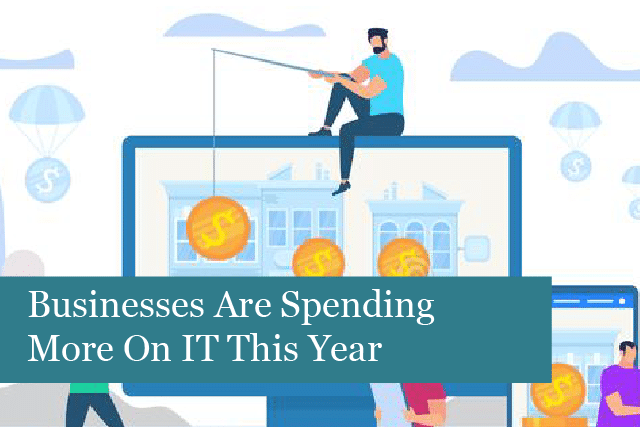
IT businesses are predicted to spend on more IT this year. UK IT spending is predicted to grow faster due to remote work and education, telehealth, and more.
According to Gartner’s most current IT Spending Outlook, the UK market is set to grow 6% from 2021 levels to $223.3 billion in 2022. What’s behind this growth in IT? It seems that IT is now transitioning from supporting businesses to being a business. According to Gartner, this means spending on technology is shifting from a cost of operations to a cost of revenue (or even a cost of goods sold).
Much of this transitioning began in the last two years when many were forced to work and shop remotely. Companies were forced to turn their networks into cloud services that provided more flexibility and stability to support workers and customers.
Increase in Using Consultant Services
Another major change has come with many businesses in the UK turning to consultancies for support. Hiring consultants means a business can hire consultants who have the specific skillsets needed for a project. Once the project has been completed successfully, the consultants are paid and they go on to the next project.
The use of consultants makes it easier for companies to scale up resources when needed.
Cloud Spending Is Up
Cloud spending is also set to increase. The reason is due to cloud computing driving an increase in IT spending. The main reason for this is enterprise software spending will also increase during 2022. However, hardware spending is expected to slow this year.
The reason for cloud spending going up is that cloud services proved their worth during the last two years. With more employees working from home and customers shopping remotely, the cloud had the scalability and flexibility needed to meet increased demand.
The cloud has shown it can scale up and down as needed with fast changes in the markets.
On the other hand, emerging tech projects have fallen behind. Businesses put AI, augmented reality, and virtual reality projects on the back burner at the same time cloud services increased.
Changes in IT Budgeting
One of the largest changes has been in CIOs’ IT budgeting. The changes are happening due to IT supplying systems that help with business tasks to support sales and revenue activities. As a result, the role and responsibility of the CIO are changing.
No longer do CIOs need to only understand a task and what tech to optimise the task. Instead, it’s now all about IT becoming the business and how to develop this capability with IT. The result is that CIOs may no longer spend the IT budget. Instead, the money may be spent by others in the C-suite.
Longer-term IT Projects Coming Back
Another major change in IT is that longer-term project planning is also making a comeback. The changes started in 2020 when companies no longer had much time to make changes. For instance, they may have had four weeks to make the change to remote work that was required.
The result of these fast changes was many businesses consolidated their vendors, depending on key vendors to keep networks up and running, with the flexibility to meet ongoing changes. With remote IT infrastructure in place, companies are now starting to look at modernisation projects for the long term.
IT Automation is a Priority
Another change in the IT sector is IT automation. Back in 2020, IT automation was at about 70%, and then it dropped to 61% in 2021. However, in 2022, this is set to increase 71%.
The main driver here is the Internet of Things (IoT) and IoT projects. Such projects fell about 47% in 2021, but now they’re back up to 54% in 2022.
SaaS Remains Top
As we move into 2022, SaaS continues to be one of the largest segments of the cloud services market. Businesses are set to break down larger apps and use them as “parts” for DevOps processes.
In addition, emerging technologies in cloud computing, including hyperscale edge computing & secure access service edge (SASE), will create more revenue streams for public cloud providers.
Changes in Business Travel Drives IT Innovation
With the end of business travel in 2020, conferences, meetings, and road warriors were sidelined. Almost all corporate travel was ended. Companies were forced to quickly change to virtual meetings and collaboration. Zoom and other software became the go-to for working online together. Throughout these fast changes, many businesses found that business travel wasn’t always necessary. Many also found business travel ate huge holes in their budget while increasing their carbon footprints.
In 2022, more companies are choosing to be more circumspect when it comes to business travel. That means more businesses are finding that virtual meetings and collaboration continue to be viable options, especially when considering budgets being squeezed by inflation. They’ve also found the value in cutting their carbon footprints in the process.
With these changes, more businesses are increasingly choosing virtual meetings and collaborative projects via Zoom, Microsoft Teams, and other apps.
Cybersecurity is Even More Important
While there have been several changes in IT, one that continues to be near the top of the IT budget is cybersecurity. Companies around the world have been hit by cyber crimes of all types from phishing to data breaches and more. Gone are the days when antivirus software was enough to protect company devices.
Today, businesses are taking a proactive stance when it comes to cybersecurity. They’re spending more on IT to ensure their networks and data are safe and secure. More companies are testing their networks to check for vulnerabilities. This may be done through in-house tests or the hiring of IT security professionals.
Summing It Up
In 2022, business leaders have realised they must be ready to meet a wide range of challenges. They must have a business that’s flexible and agile in order to remain successful, no matter what issues they face.
With the experiences of the past two years, more companies are choosing to increase their IT spending. It’s no longer viewed as a cost. Instead, IT budgets are seen as an investment in the productivity, resilience, and success of the business.
Recommended Posts

The Importance of Planning in Business IT Solutions
11th April 2025


